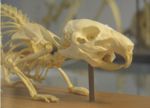Diferencia entre revisiones de «Fórmula Dental - Roedores»
Ir a la navegación
Ir a la búsqueda
(Página creada con '==Chinchillas and Guinea-pigs== thumb|right|150px|Guinea-pig Teeth - Copyright RVC The formula for permanent teeth is: 2 (I1/1 C0/0 P1/1 M3/3) ...') |
|||
| Línea 1: | Línea 1: | ||
| − | ==Chinchillas | + | ==Chinchillas y Conejillos de Indias== |
| − | [[Image:Guinea-pig skull.jpg|thumb|right|150px| | + | [[Image:Guinea-pig skull.jpg|thumb|right|150px|Dientes de un Conejillo de Indias - Copyright RVC]] |
| − | + | La fórmula para los dientes permanentes es: 2 (I1/1 C0/0 P1/1 M3/3) | |
==Roedores== | ==Roedores== | ||
| − | [[Image:Rodent Dental System.jpg|thumb|right|150px| | + | [[Image:Rodent Dental System.jpg|thumb|right|150px|Sistema Dental de un Roedor - Copyright RVC]] |
| + | |||
| + | La fórmula para los dientes permanentes es: 2 (I1/1 C0/0 P0/0 M3/3) | ||
| − | |||
[[Categoría:Dientes - Anatomía & Fisiología]] | [[Categoría:Dientes - Anatomía & Fisiología]] | ||
[[Categoría:Roedores - Sistema Alimentario]] | [[Categoría:Roedores - Sistema Alimentario]] | ||

